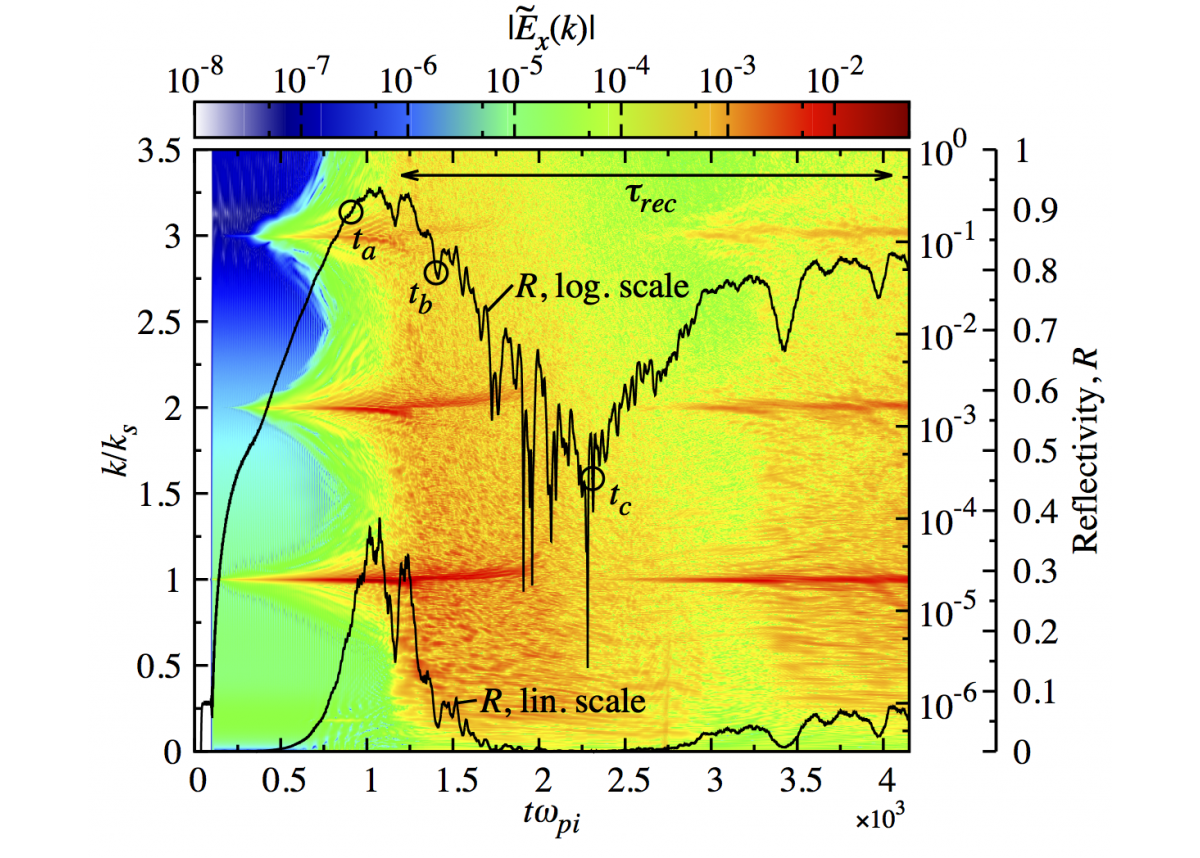Thomas Chapman (15-ERD-038)
Abstract
The scattering of laser light by plasma waves, also known as laser–plasma interactions, is of central importance to a vast array of fundamental physics experiments and the field of laser-driven Inertial Confinement Fusion. Because of diversion and reflection of laser light, laser–plasma interactions pose a serious threat to optical hardware and greatly reduces the laser energy coupled to the target during long-pulse, high-power experiments. An adequate description of the propagation of intense, coherent laser light through hot, high-density plasma is fundamental to current and future laser–plasma interactions experiments. Our goal is to undertake the multiscale challenge of simulating these interactions and thereby bridge the gap between the mesoscale fluid modeling and microscale kinetic modeling of these interactions. Numerical simulation is an essential component of the effort to understand, predict, and mitigate laser–plasma interactions, and ultimately to increase the total laser energy delivered to the desired target. This project focuses on the inclusion and validation of new kinetic physics models in a fluid-like simulation code, in addition to basic advances in modeling kinetic laser–plasma interactions.
We expect to provide a path to progress in the field of laser–plasma interactions at LLNL. The multiscale approach we are pursuing presents a clear opportunity to enhance and increase confidence in laser–plasma interaction modeling, addressing the gulf between fluid-like simulations that can be applied to experimental scales but that omit nonlinear plasma-wave physics. In addition, we anticipate examining fully kinetic simulations that include nonlinear plasma-wave physics, but cannot be applied to experimental scales. Our goal is to develop, implement, and validate new physics models in the fluid-like multiphysics code pF3D used to study laser–plasma interactions, as well as novel basic plasma physics results obtained in tandem using the cutting-edge code LOKI for plasma physics, which is a high-order accurate solver for the kinetic Vlasov equation of the distribution function in a plasma. (The Vlasov equation describes the time evolution of the distribution function of a plasma consisting of charged particles with long-range interaction.) We will examine several key plasma physics areas including advection and deposition of energy transferred from plasma waves to the background distribution of particles, and fluid-like models of inherently kinetic processes that affect the amplitude or coherence of ion acoustic waves and electron plasma waves that will be developed and implemented in the pF3D code. We will also simulate the evolution of plasma waves with collisions to determine the threshold for onset of trapping and collisional effects on Landau damping of the amplitude of plasma waves.
Mission Relevance
Our research into advancing simulation capability by extending the physical regime of applicability of fluid codes will inform future predictive and diagnostic simulations, in support of the Laboratory's strategic focus area in stockpile stewardship science, in addition to the core competency in high-energy-density science. This project will further enhance the unique suite of LLNL high-energy-density physics simulation codes by extending the capabilities of the two-dimensional Vlasov code LOKI.
FY15 Accomplishments and Results
In FY15 we (1) incorporated an electromagnetic solver in the multiple-species LOKI code for the regime of stimulated Raman scattering and completed basic testing; (2) implemented a complete collisions operator, including pitch-angle scattering and thermalization in LOKI, as well as significant improvements to the scalability of the code; (3) implemented a broadband noise source in LOKI to facilitate transfer of results from LOKI to pF3D and the construction of reduced models; and (4) began developing a plasma-wave energy record in pF3D.
Publications and Presentations
- Banks, J. W., et al., “Vlasov simulations of electron–ion collision effects on damping of electron plasma waves.” Plasma Phys. arXiv:1601.01002v1 (2015). LLNL-JRNL-669228.
- Banks, J. W., et al., Vlasov simulation of the effects of pitch angle collisions on Landau and collisional damping of electron plasma waves. 45th Ann. Anomalous Absorption Conf., Ventura, CA, June 14–19, 2015. LLNL-ABS-669451.
- Berger, R. L., et al., “Multi-dimensional Vlasov simulations and modeling of trapped-electron-driven filamentation of electron plasma waves.” Phys. Plasma. 22, 055703 (2015). LLNL-JRNL-664157.
- Berger, R. L., et al., Two-dimensional Vlasov simulations of a transverse modulational instability of ion acoustic waves. APS March Mtg., San Antonio, TX, Mar. 2–6, 2015. LLNL-ABS-648403.
- Berger, R. L., et al., Wave bowing and modulational instability of ion acoustic waves in 2D Vlasov simulations. 45th Ann. Anomalous Absorption Conf., Ventura, CA, June 14–19, 2015. LLNL-ABS-669449.
- Chapman, T., et al., "Demonstrating the saturation of stimulated Brillouin scattering by ion acoustic decay using fully kinetic simulations." Phys. Plasma. 22, 092116 (2015). LLNL-JRNL-667961.
- Chapman, T., et al., Ion acoustic wave decay to two daughter waves using a 2D+2V Vlasov code. (2015). LLNL-ABS-669899.
- Chapman, T., et al., The stability of freely-propagating ion acoustic waves in 2D systems. 56th Ann. Mtg APS Division of Plasma Physics, New Orleans, LA, Oct. 27–31, 2014. LLNL-ABS-656470.
- Khodak, M., et al., A multi-fluid model for interpenetrating plasma flows. 56th Ann. Mtg APS Division of Plasma Physics, Savannah, GA, Nov. 16–20, 2015. LLNL-PRES-676777.






